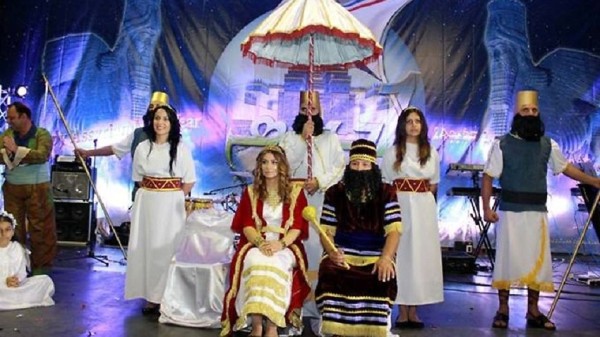
Modern Assyrian in ancient Assyrian royal costumes Source: AANF.jpg
Ishtartv.com - sbs.com.au
BY
NINOS EMMANUEL, 23 March, 2022
The
Akitu Festival was celebrated in 12 consecutive days during the
Assyrian-Babylonian empires period with different rituals and activities in
each one of those days
The
modern Syriac people have been celebrating the Akitu or Assyrian-Babylonian new
year for decades, in their homeland and around the world. There are tens or
even hundreds of articles and documents telling the story of Akitu. We
summarised it for you in this article and audio podcast.
Ancient
Assyrians-Babylonians celebrated the Akitu festival on 12 consecutive days.
Here is what was happening each day.
Day
One: On this day, Assyrians dedicate their time on this day to pray to the
Gods, after that they will start preparing for the second day's festivities.
Day
Two: Before sunrise, the high priest would take a bath in the Euphrates
river, when he comes out, he would put on a white dress to symbolise purity.
Then he enters the temple to pray to the Gods to bless him and bless the
nation. Then other priests would enter the temple and start praying.
Day
Three: Before sunset, priests would be praying, then the people would join
the prayers. Then the king would bring the statue of Nabu son of Marduk and
takes it inside the temple to be worshipped.
Day
Four: The High priests start telling stories about the creation. The
general public would be singing and dancing. This day is a day of memorial and
celebration.
Day
five: General public would gather on the edge of the river to cook and eat
and celebrate while waiting for the arrival of the king.
On
his arrival, the king would be escorted to the temple by the High Priest.
There, the king will take off his throne, his imperial gown and kneel in front
of the Gods and tell them that he has no sin or ill-feeling against them, his
people and his kingdom. this is a symbol of humbleness.
Then
the priests accept the king's confession and put his Royal attire back on, and
reintroduce him to the public and the celebration starts again.
Day
Six: The priests bring all God's statues from all the cities and bring
them inside the temple.
Day
seven: On this day, God Marduk would disappear, nobody would know his
whereabouts. This means he went to fight with Goddess Tiamat. Now he is
imprisoned in the mountains of the universe, then God Nabu with other Gods will
go into a mission to rescue him.
Day
Eight: On this day, the king would hold the hand of God Marduk and
introduce him to other gods. Then all those Gods would give their power to
Marduk, and he becomes the Supreme God.
Day
Nine: Day nine would see a huge procession. The king will be in front and
Gods would be in procession floats, covered with gold and precious blue stones.
In the first float, there will be four priests to assist God Marduk. The second
float would be the royal carriage drawn by three horses, followed by other
floats.
Day
Ten: Marduk starts celebrating his victory along with the Gods of Heaven
and earth. At the end of the feast and celebration, Marduk would return to the
capital city to start the Holy marriage ceremony.
This
marriage is necessary to ensure the fertility of the land.
Day
Eleven: On this day, the Gods would perform a ritual of Determination
of Destiny of humanity for the coming year.
Day
Twelve: Final day of the festival
The
Gods would return to the temple while people continue to celebrate.
|